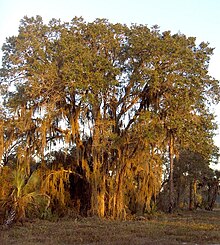Live oak


Live oakorevergreen oakis any of a number ofoaksin several different sections of the genusQuercusthat share the characteristic ofevergreenfoliage.[1]These oaks are generally not more closely related to each other than they are to other oaks.[1]When the term live oak is used in a specific rather than general sense, it most commonly refers to the group of species underQuercussect.Virentes,which includes thesouthern live oak(Quercus virginiana), the first species so named, and an icon of theOld South.[2]
The namelive oakcomes from the fact that evergreen oaks remain green and "live" throughout winter, when other oaks are dormant and leafless. The name is used mainly inNorth America,where evergreen oaks are widespread in warmer areas along theAtlanticcoast from southeastVirginiatoFlorida,west along theGulf CoasttoLouisianaandMexico,and across the southwest toCalifornia.
Evergreen oak species are also common in parts ofsouthern Europeand southAsia,and are included in this list for the sake of completeness. These species, although not having "live" in their common names in their countries of origin, are colloquially called live oaks when cultivated in North America.
According to theLive Oak Societythe oldest southern live oak is believed to be theSeven Sisters Oaklocated inMandeville, Louisianawith an estimated age of 500–1,000 years.[3]
The southern live oak is the official state tree ofGeorgia.
TheSeal of Texasincludes a live oak branch.
A smallgroveof live oaks on a prairie is known as amott.[4]
Wood and lumber
[edit]This sectionneeds additional citations forverification.(May 2020) |
Live oak was widely used in early Americanbutt shipbuilding.Because of the trees' short height and low-hanging branches, lumber from live oaks was used in curved parts of the frame, such as knee braces (single-piece, L-shaped braces that spring inward from the side and support the deck), in which the grain runs perpendicular to structural stress, making for exceptional strength.[5]Live oaks were not generally used for planking because the curved and often convoluted shape of the tree did not lend itself to being milled to planking of any length. "The world's oldest floating ship, the USS Constitution, launched in 1797, got its nickname" Old Ironsides "during the War of 1812 after its hull, made in part of live oak, proved equal to the fearsome cannons of the British".[5]
Loggers had cut down most of the live oak trees in southern Europe by the latter half of the 19th century. Live oak timber from the United States was similarly sought and exported until metal-hulled commercial vessels became the norm in the early part of the 20th century. Live oak lumber is rarely used for furniture, because it warps and twists while drying.
The wood of live oaks continues to be used occasionally in shipbuilding—and in tool handles for its strength, energy absorption, and density, although modern composites are often substituted with good effect. Dry Southern live oak lumber has aspecific gravityof 0.88, among the highest of North American hardwoods.
List of evergreen species in genusQuercus
[edit]- SectionQuercus.Thewhite oaks– Europe, Asia, North Africa, North America, styles short; acorns mature in six months, sweet or slightly bitter, inside of acorn shell is hairless
- Quercus arizonica– Arizona white oak – southwestern North America
- Quercus fusiformis– (alsoQuercus virginiana var. fusiformis) Texas live oak – south central North America
- Quercus geminata– sand live oak – southeastern North America
- Quercus greggii– Gregg oak – Mexico
- Quercus hinckleyi– Hinckley oak – Texas
- Quercus ilex– Holm oak – southern Europe
- Quercus minima– dwarf live oak – southeastern North America
- Quercus oblongifolia– Mexican blue oak – southwestern North America
- Quercus polymorpha– Mexican white oak or Monterrey oak – Mexico
- Quercus pungens– sandpaper oak – south central North America
- Quercus rotundifolia− holm oak − southwestern Europe and northwestern Africa
- Quercus turbinella– shrub live oak – southwestern North America
- Quercus virginiana– southern live oak – southeastern North America
- SectionCerris.Europe, Asia, north Africa. Styles long; acorns mature in 18 months, very bitter, inside of acorn shell is hairless or slightly hairy
- Quercus calliprinos– Palestine oak – western Asia
- Quercus coccifera– Kermes oak – southern Europe
- Quercus semecarpifolia– Himalayan oak – eastern Asia
- Quercus suber– Cork oak – southwestern Europe
- SectionProtobalanus– Southwest US, California coastal ranges and northwest Mexico, styles short, acorns mature in 18 months, very bitter, inside of acorn shell is woolly
- Quercus cedrosensis— Cedros Island oak — Baja California
- Quercus chrysolepis– canyon live oak – southwestern North America, especially coastal ranges of California
- Quercus palmeri– Palmer oak – southwestern North America
- Quercus tomentella– Channel Island oak –Channel Islands of California
- Quercus vacciniifolia– huckleberry oak – California and southwestern North America
- SectionLobatae.Thered oaks– North, Central and South America, styles long, acorns mature in 18 months, very bitter, inside of acorn shell is woolly
- Quercus agrifolia– coast live and sharpacorn oaks – California and Mexico
- Quercus canbyi– Canby oak – Mexico
- Quercus emoryi– Emory oak – southwestern North America
- Quercus hemisphaerica– laurel oak – southeastern North America
- Quercus humboldtii– South American oak – northern South America
- Quercus laurifolia– swamp laurel oak – southeastern U.S.
- Quercus hypoleucoides– silverleaf oak – southwestern North America
- Quercus parvula– Santa Cruz Island and Shreve oaks – California
- Quercus rysophylla– loquat leaf oak – Mexico
- Quercus wislizeni– interior live oak – California and Mexico
- See thelist of Quercus speciesfor a fuller listing of oaks, includingdeciduousspecies.
References
[edit]- ^abMiller, George Oxford (7 April 2006).Landscaping with Native Plants of Texas.Voyageur Press. p. 82.ISBN9780760325391.Retrieved20 October2010.
- ^Bender, Steve, ed. (January 2004). "Quercus virginiana".The Southern Living Garden Book(2nd ed.). Birmingham, Alabama: Oxmoor House.ISBN0-376-03910-8.
- ^Guion, William (Summer 2018)."Before America Was America".American Forests.Retrieved2020-11-22.
- ^Wheat, Pam; Whorton, Brenda (November 1990).Clues from the Past: A Resource Book on Archeology.Hendrick-Long Pub. Co. p. 18.ISBN9780937460658.Retrieved20 October2010.
- ^abSteadfast Majestic and sturdy the live oak tree has offered protection time and againSmithsonian magazine April/May 2023 issue Pages 17-19 by Shannon Sims
